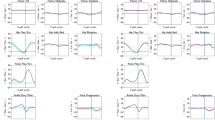Abstract
When two fundamental gait parameters—step length and step frequency—are scaled non-dimensionally, thereby accounting for increases in a child's physical size, ontogenetic changes in the locomotor control strategy are revealed. We believe dimensionless velocity β, the product of dimensionless step length and frequency, serves as a measure of neural development. It increases from the age of 18 months and reaches a plateau between 50 and 90 months, attaining the adult value of 0.45. Based on a study of 200 children, our findings lend support to a theory that posits a neuromaturation growth curve with the form: β (t)=0.45 (1−e−0.05t) where t is the age in months and 0.05 is the growth coefficient.


Similar content being viewed by others
References
Adolph KE, Vereijken B, Shrout PE (2003) What changes in infant walking and why. Child Dev 74:475–497
Alexander RM (1984) Stride length and speed for adults, children, and fossil hominids. Am J Phys Anthropol 63:23–27
Alexander RM (1992) Exploring biomechanics. Animals in motion. Scientific American Library, New York
Alexander RM, Jayes AS (1983) A dynamic similarity hypothesis for the gaits of quadrupedal mammals. J Zool 201:135–152
Beck RJ, Andriacchi TP, Kuo KN, Fermier RW, Galante JO (1981) Changes in gait patterns in growing children. J Bone Joint Surg 63A: 1452–1457
DeJaeger D, Willems PA, Heglund NC (2001) The energy cost of walking in children. Eur J Physiol 441:538–543
Forssberg H (1985) Ontogeny of human locomotor control. 1. Infant stepping, supported locomotion and transition to independent locomotion. Exp Brain Res 57:480–493
Forssberg H (1992) Evolution of plantigrade gait: is there a neuronal correlate? Dev Med Child Neurol 34:920–925
Forssberg H (1999) Neural control of human motor development. Curr Opin Neurobiol 9:676–682
Hof AL (1996) Scaling gait data to body size. Gait Posture 4:222–223
Hof AL, Zijlstra W (1997) Comment on "normalization of temporal-distance parameters in pediatric gait". J Biomech 30:299
Jeng SF, Liao HF, Lai JS, Hou JW (1997) Optimization of walking in children. Med Sci Sports Exerc 29:370–376
Koehl MAR (2000) Consequences of size change during ontogeny and evolution. In: Brown JH, West GB (eds) Scaling in biology. Oxford University Press, New York, pp 67–86
Lamb T, Yang JF (2000) Could different directions of infant stepping be controlled by the same locomotor central pattern generator? J Neurophysiol 83:2814–2824
McMahon TA, Bonner JT (1983) On size and life. Scientific American Library, New York
Muir GD (2000) Early ontogeny of locomotor behaviour: a comparison between altricial and precocial animals. Brain Res Bull 53:719–726
Okamoto T, Okamoto K, Andrew PD (2003) Electromyographic developmental changes in one individual from newborn stepping to mature walking. Gait Posture 17:18–27
O'Malley MJ (1996) Normalization of temporal-distance parameters in pediatric gait. J Biomech 29:619–625
O'Malley MJ, Abel MF, Damiano DL, Vaughan CL (1997) Fuzzy clustering of children with cerebral palsy based on temporal-distance gait parameters. IEEE Trans Rehabil Eng 5:300–309
Pinter MM, Dimitrijevic MR (1999) Gait after spinal cord injury and the central pattern generator for locomotion. Spinal Cord 37:531–537
Sporns O, Edelman GM (1993) Solving Bernstein's problem: a proposal for the development of coordinated movement by selection. Child Dev 64:960–981
Stansfield BW, Hillman SJ, Hazlewood ME, Lawson AM, Mann AM, Louden IR, Robb JE (2003) Normalisation of gait in children. Gait Posture 17:81–87
Subramanian N, Vaughan CL, Peter JC, Arens LJ (1998) Gait before and ten years after rhizotomy in children with cerebral palsy spasticity. J Neurosurg 88:1014–1019
Sutherland D (1997) The development of mature gait. Gait Posture 6:163–170
Sutherland DH, Olshen R, Cooper L, Woo SL (1980) The development of mature gait. J Bone Joint Surg 62A:336–353
Thelen E, Skala K, Kelso JAS (1987) The dynamic nature of early coordination: evidence from bilateral leg movements in young infants. Dev Psychobiol 23:179–186
Vaughan CL (2003) Theories of bipedal walking: an odyssey. J Biomech 36:513–523
Vaughan CL, Damiano DL, Abel MF (1997) Gait of normal children and those with cerebral palsy. In: Allard P, Cappozzo A, Lundberg A, Vaughan CL (eds) Three-dimensional analysis of human locomotion. John Wiley, Chichester, pp 335–361
Vaughan CL, Subramanian N, Busse ME (1998) Rhizotomy as a treatment option for children with cerebral palsy. Gait Posture 8:43–59
Vaughan CL, Davis BL, O'Connor J (1999) Dynamics of human gait. Kiboho Publishers, Cape Town
von Bertalanffy L (1938) A quantitative theory of organic growth. Hum Biol 10:181–213
West GB, Brown JH, Enquist BJ (2001) A general model for ontogenetic growth. Nature 403:628–631
Yaguramaki N, Kimura T (2002) Acquirement of stability and mobility in infant gait. Gait Posture 16:69–77
Yang JF, Stephens MJ, Vishram R (1998) Infant stepping: a method to study the sensory control of human walking. J Physiol 507:927–937
Acknowledgements
We thank Gerard Deib, Harmen Leskens and Fernando Martinez for their assistance in gathering and analyzing the data. We also acknowledge the financial assistance of The Wellcome Trust, the Medical Research Council of South Africa, and Stichting Nijmeegs Universiteits Fonds. Christopher Vaughan was an Ernest Walton Fellow, funded by Science Foundation Ireland, when this work was completed.
Author information
Authors and Affiliations
Corresponding author
Rights and permissions
About this article
Cite this article
Vaughan, C.L., Langerak, N.G. & O'Malley, M.J. Neuromaturation of human locomotion revealed by non-dimensional scaling. Exp Brain Res 153, 123–127 (2003). https://doi.org/10.1007/s00221-003-1635-x
Received:
Accepted:
Published:
Issue Date:
DOI: https://doi.org/10.1007/s00221-003-1635-x




